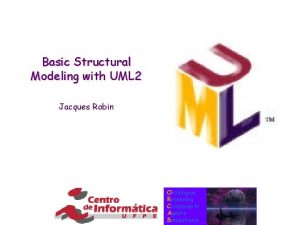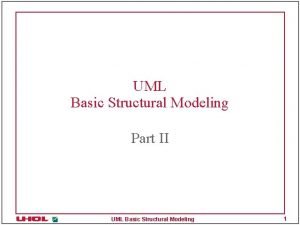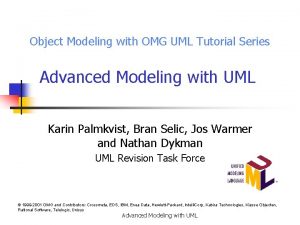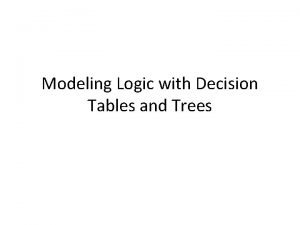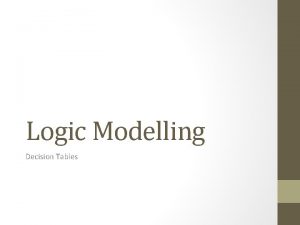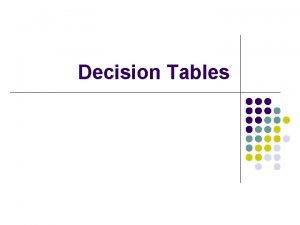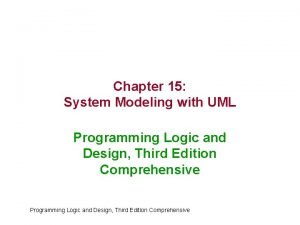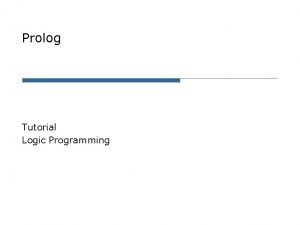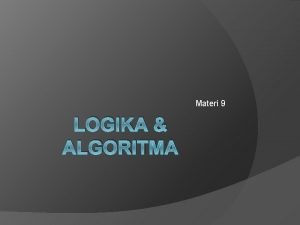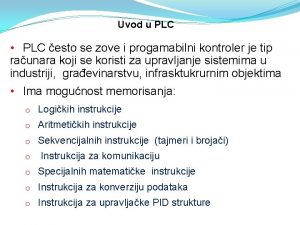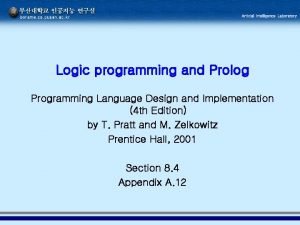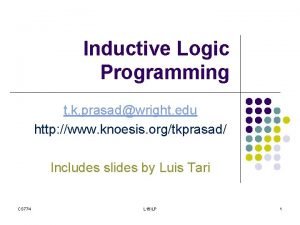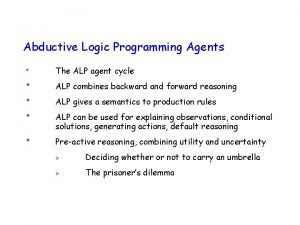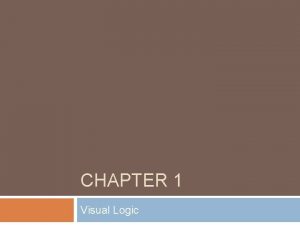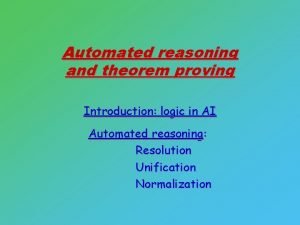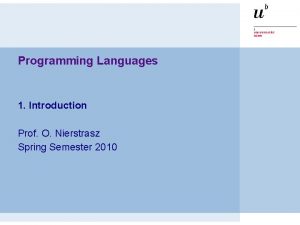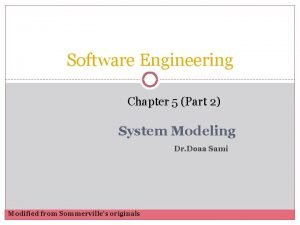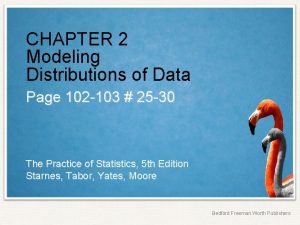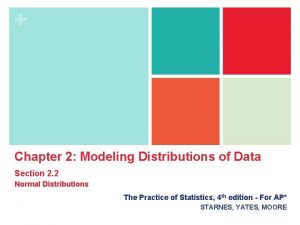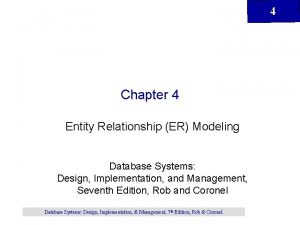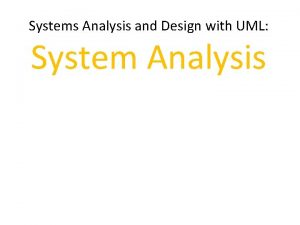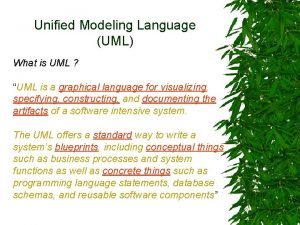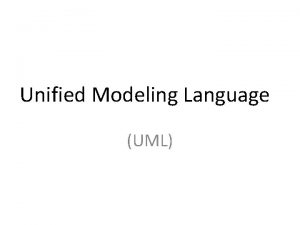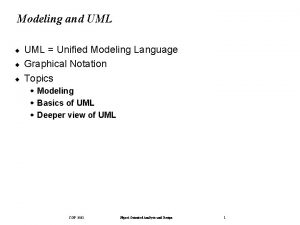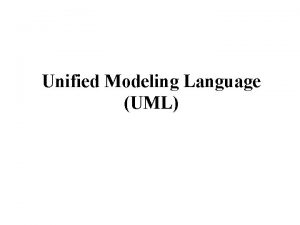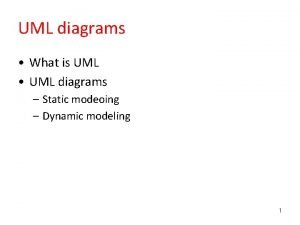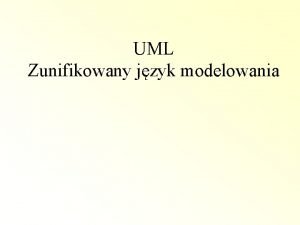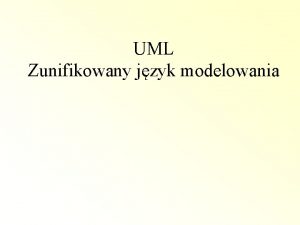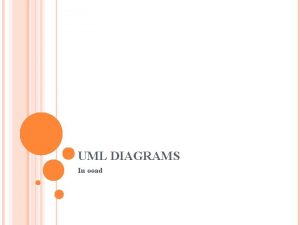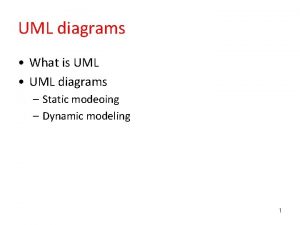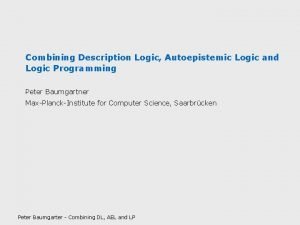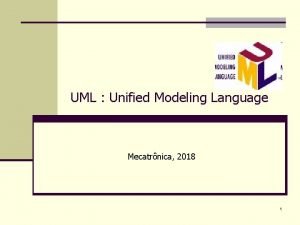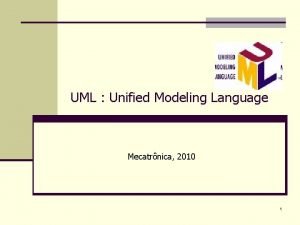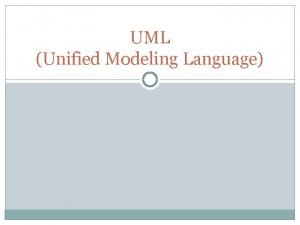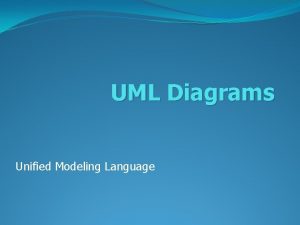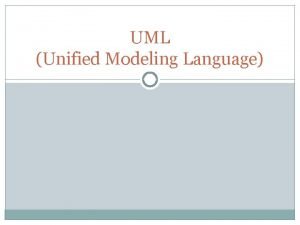Chapter 15 System Modeling with UML Programming Logic













































- Slides: 45

Chapter 15: System Modeling with UML Programming Logic and Design, Third Edition Comprehensive

Objectives • After studying Chapter 15, you should be able to: • Understand the need for system modeling • Describe the UML • Work with use case diagrams • Use class and object diagrams • Use sequence and collaboration diagrams Programming Logic and Design, Third Edition Comprehensive 2

Objectives (continued) • Use statechart diagrams • Use activity diagrams • Use component and deployment diagrams • Decide which UML diagrams to use Programming Logic and Design, Third Edition Comprehensive 3

Understanding the Need for System Modeling • Computer programs often stand alone to solve a user’s specific problem • Producing a set of programs that operate together correctly requires careful planning • System design: – detailed specification of how all the parts of a system will be implemented and coordinated Programming Logic and Design, Third Edition Comprehensive 4

Understanding the Need for System Modeling (continued) • Some basic principles: – Large systems are easier to understand when you break them down into subsystems – Good modeling techniques are increasingly important as the size and complexity of systems increase – Good models promote communication among technical and non-technical workers while ensuring good business solutions Programming Logic and Design, Third Edition Comprehensive 5

What Is UML? • Unified Modeling Language – Standard way to specify, construct, and document systems that use object-oriented methods – Modeling language, not a programming language – Provides nine different diagram types that you can use to model systems Programming Logic and Design, Third Edition Comprehensive 6

What Is UML? (continued) • Each of the diagram types lets you see a business process from a different angle, and appeals to a different type of user • The nine UML diagram types are: – Use case diagrams – Class diagrams – Object diagrams – Sequence diagrams – Collaboration diagrams – Statechart diagrams – Activity diagrams – Component diagrams – Deployment diagrams Programming Logic and Design, Third Edition Comprehensive 7

Using Use Case Diagrams • Use case diagram: – shows how a business works from the perspective of those who approach it from the outside, or those who actually use the business • Many types of users—for example, employees, customers, and suppliers • Use cases do not necessarily represent all the functions of a system – Are the system functions or services that are visible to the system’s actors Programming Logic and Design, Third Edition Comprehensive 8

Using Use Case Diagrams (continued) • Figure 15 -1 shows a use case diagram for these two events Programming Logic and Design, Third Edition Comprehensive 9

Using Use Case Diagrams (continued) • In many systems, there are variations in use cases • The three possible types of variations are: 1. Extend: – Shows functions beyond those found in a base case – For example, checking out a book for a new library patron who doesn’t have a library card is slightly more complicated then checking out a book for an existing patron Programming Logic and Design, Third Edition Comprehensive 10

Using Use Case Diagrams (continued) • Each variation in the sequence of actions required in a use case is a scenario • Extended use cases are shown in an oval with a dashed arrow pointing to the more general base case Programming Logic and Design, Third Edition Comprehensive 11

Using Use Case Diagrams (continued) • For clarity, add “<<extend>>” near line that shows relationship extension • Stereotype: • Adds to UML vocabulary of shapes to make them more meaningful for the reader • Figure 15 -3 includes a stereotype Programming Logic and Design, Third Edition Comprehensive 12

Using Use Case Diagrams (continued) 2. Include – Use when a case can be part of multiple use cases Programming Logic and Design, Third Edition Comprehensive 13

Using Use Case Diagrams (continued) • Use a generalization when – a use case is less specific than others – you want to be able to substitute the more specific case for a general one • Figure 15 -5 shows the generalization acquire. New. Item() with two more specific situations: acquiring videos and CDs – The more specific scenarios are attached to the general scenario with open-headed dashed arrows Programming Logic and Design, Third Edition Comprehensive 14

Use Case Diagram for Librarian, with Generalization Programming Logic and Design, Third Edition Comprehensive 15

Using Use Case Diagrams (continued) • A use case diagram is only a tool to aid communication • No single “correct” use case diagram exists; you might correctly represent a system in several ways • For example, you might choose to emphasize the actors in the library system, as shown in Figure 15 -7, or to emphasize system requirements, as shown in Figure 15 -8 Programming Logic and Design, Third Edition Comprehensive 16

Use Case Diagram Emphasizing Actors Programming Logic and Design, Third Edition Comprehensive 17

Use Case Diagram Emphasizing System Requirements Programming Logic and Design, Third Edition Comprehensive 18

Using Class and Object Diagrams • You use a class diagram to illustrate the names, attributes, and methods of a class or set of classes – More useful to system’s programmers than to users because they closely resemble code the programmers will write Programming Logic and Design, Third Edition Comprehensive 19

Using Class and Object Diagrams (continued) • A class diagram illustrating a single class contains a rectangle divided into three sections (Figure 15 -9) – the top section contains the name of the class – the middle section contains the name of the attributes – the bottom section contains the names of the methods Programming Logic and Design, Third Edition Comprehensive 20

Using Class and Object Diagrams (continued) • Class diagrams can include symbols that show the relationships between objects • You can show two types of relationships: – An association relationship – A whole-part relationship Programming Logic and Design, Third Edition Comprehensive 21

Using Class and Object Diagrams (continued) • Association relationship: – Describes the connection or link between objects – Represented by a straight line • Frequently, you include information about the arithmetical relationship or ratio (called cardinality or multiplicity) of the objects – For example, Figure 15 -11 shows the association relationship between a Library and the Library. Items it lends Programming Logic and Design, Third Edition Comprehensive 22

Using Class and Object Diagrams (continued) • Figure 15 -12 adds the Patron class to the diagram and shows how you indicate that any number of Patrons can be associated with the Library, but that each Patron can borrow only up to five Library. Items at a time, or currently might not be borrowing any • In addition, each Library. Item can be associated with at most one Patron, but at any given time might not be on loan Programming Logic and Design, Third Edition Comprehensive 23

Using Class and Object Diagrams (continued) Programming Logic and Design, Third Edition Comprehensive 24

Class Diagram with Several Association Relationships Programming Logic and Design, Third Edition Comprehensive 25

Using Class and Object Diagrams (continued) • Whole-part relationship: – describes an association in which one or more classes make up the parts of a larger whole class – For example, 50 states “make up” the United States, and 10 departments might “make up” a company – Also called an aggregation – Represented by an open diamond at the “whole part” end of the line that indicates the relationship Programming Logic and Design, Third Edition Comprehensive 26

Class Diagram with Whole-Part Relationship Programming Logic and Design, Third Edition Comprehensive 27

Using Class and Object Diagrams (continued) • You also can call a whole-part relationship a hasa relationship • Figure 15 -13 shows a whole-part relationship for a Library • Object diagrams are similar to class diagrams, but they model specific instances of classes – Use to show a snapshot of an object at one point in time, so you can more easily understand its relationship to other objects Programming Logic and Design, Third Edition Comprehensive 28

Object Diagram for Library Programming Logic and Design, Third Edition Comprehensive 29

Using Sequence and Collaboration Diagrams • Use a sequence diagram to show the timing of events in a single use case – makes it easier to see the order in which activities occur • The horizontal axis (x-axis) of a sequence diagram represents objects • The vertical axis (y-axis) represents time – For example, Figure 15 -15 shows a sequence diagram for a scenario that a librarian can use to create a book checkout record Programming Logic and Design, Third Edition Comprehensive 30

Using Sequence and Collaboration Diagrams (continued) • A collaboration diagram emphasizes the organization of objects that participate in a system – contains sequence numbers to represent the precise order in which activities occur • Figure 15 -16 shows the same sequence of events as Figure 15 -15, – but the steps to creating a Book. Check. Out. Record are clearly numbered Programming Logic and Design, Third Edition Comprehensive 31

Sequence Diagram for Checking Out a Book for a Patron Programming Logic and Design, Third Edition Comprehensive 32

Collaboration Diagram for Checking Out a Book for a Patron Programming Logic and Design, Third Edition Comprehensive 33

Using Statechart Diagrams • Statechart diagram: – shows the different status of a class or object at different points in time – Use to illustrate aspects of a system that show interesting changes in behavior as time passes • Figure 15 -17 contains a statechart diagram you can use to describe the states of a Book Programming Logic and Design, Third Edition Comprehensive 34

Statechart Diagram for Book Class Programming Logic and Design, Third Edition Comprehensive 35

Using Activity Diagrams • The UML diagram that most closely resembles a conventional flowchart is an activity diagram: – shows the flow of actions of a system, including branches that occur when decisions affect the outcome – use flowchart start and stop symbols (called lozenges) to describe actions – Use solid dots to represent start and stop states Programming Logic and Design, Third Edition Comprehensive 36

Using Activity Diagrams (continued) • Like flowcharts, activity diagrams use diamonds to describe decisions • Unlike the diamonds in flowcharts, the diamonds in UML activity diagrams usually are empty – possible outcomes are documented along the branches emerging from the decision symbol – Figure 15 -18 shows a simple activity diagram with a single branch Programming Logic and Design, Third Edition Comprehensive 37

Activity Diagram Showing Branch Programming Logic and Design, Third Edition Comprehensive 38

Using Component and Deployment Diagrams • Component and deployment diagrams model the physical aspects of systems • Component diagram: – Use to emphasize files, database tables, documents, and other components that a system’s software uses • Deployment diagram: – Use to focus on a system’s hardware Programming Logic and Design, Third Edition Comprehensive 39

Using Component and Deployment Diagrams • You can use a variety of icons in each type of diagram, but each icon must convey meaning to the reader • Figures 15 -20 and 15 -21 shows component and deployment diagrams that illustrate aspects of a library system Programming Logic and Design, Third Edition Comprehensive 40

Component Diagram Programming Logic and Design, Third Edition Comprehensive 41

Deployment Diagram Programming Logic and Design, Third Edition Comprehensive 42

Deciding Which UML Diagrams to Use • Each of the nine UML diagram types provides a different view of a system • Just as a portrait artist, psychologist, and neurosurgeon each prefer a different conceptual view of your head, – the users, managers, designers, and technicians of computer and business systems each prefer specific system views Programming Logic and Design, Third Edition Comprehensive 43

Summary • System design is the detailed specification of how all the parts of a system will be implemented and coordinated • A use case diagram shows how a business works from the perspective of those who approach it from the outside, or those who actually use the business • You use a class diagram to illustrate the names, attributes, and method of a class or set of classes Programming Logic and Design, Third Edition Comprehensive 44

Summary (continued) • You use a sequence diagram to show the timing of events in a single use case • A statechart diagram shows the different status of a class or object at different points in time • You use a component diagram when you want to emphasize the files, database tables, documents, and other components that a system’s software uses Programming Logic and Design, Third Edition Comprehensive 45
 Erickson nursing theory
Erickson nursing theory Dimensional modeling vs relational modeling
Dimensional modeling vs relational modeling Superstruture
Superstruture Structural modeling in uml
Structural modeling in uml Uml modeling tutorial
Uml modeling tutorial Uml interaction overview diagram
Uml interaction overview diagram What is system programing
What is system programing Uml 1..*
Uml 1..* Modeling logic with decision tables
Modeling logic with decision tables Modeling logic with decision tables
Modeling logic with decision tables Decision table شرح
Decision table شرح Logic design uml
Logic design uml First order logic vs propositional logic
First order logic vs propositional logic First order logic vs propositional logic
First order logic vs propositional logic Third order logic
Third order logic Combinational logic circuit vs sequential
Combinational logic circuit vs sequential Cryptarithmetic problem logic+logic=prolog
Cryptarithmetic problem logic+logic=prolog Combinational logic sequential logic 차이
Combinational logic sequential logic 차이 Majority circuit
Majority circuit Combinational logic sequential logic 차이
Combinational logic sequential logic 차이 Logic chapter three
Logic chapter three Logic programming tutorial
Logic programming tutorial Algoritma looping
Algoritma looping Plc
Plc Prolog design
Prolog design Logic programming example
Logic programming example Automated logic programming
Automated logic programming Abductive logic programming alp
Abductive logic programming alp Visual logic programming
Visual logic programming Programming logic exercises
Programming logic exercises Logic programming
Logic programming Perbedaan linear programming dan integer programming
Perbedaan linear programming dan integer programming Greedy vs dynamic programming
Greedy vs dynamic programming Linear vs integer programming
Linear vs integer programming Programing adalah
Programing adalah Mhc-pms use case diagram
Mhc-pms use case diagram Dfd ch5
Dfd ch5 Requirements modeling in system analysis and design
Requirements modeling in system analysis and design What is system modeling in software engineering
What is system modeling in software engineering Mathematical modelling of mechanical systems examples
Mathematical modelling of mechanical systems examples Chapter 2 modeling distributions of data
Chapter 2 modeling distributions of data Chapter 2 modeling distributions of data
Chapter 2 modeling distributions of data Composite entity example
Composite entity example Which of these can be actors in a use case diagram
Which of these can be actors in a use case diagram Online gym management system
Online gym management system System analysis and design with uml
System analysis and design with uml


